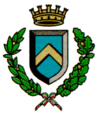Mirandola
| Mirandola | ||
|---|---|---|
| Comune | ||
| Comune di Mirandola | ||
|
| ||
| ||
 Mirandola Location of Mirandola in Italy | ||
| Coordinates: 44°53′12″N 11°4′0″E / 44.88667°N 11.06667°ECoordinates: 44°53′12″N 11°4′0″E / 44.88667°N 11.06667°E | ||
| Country | Italy | |
| Region | Emilia-Romagna | |
| Province / Metropolitan city | Modena | |
| Frazioni | Cividale, Gavello, Mortizzuolo, Quarantoli, San Giacomo Roncole, San Martin Carano, San Martino Spino, Tramuschio | |
| Government | ||
| • Mayor | Maino Benatti | |
| Area | ||
| • Total | 137.1 km2 (52.9 sq mi) | |
| Elevation | 18 m (59 ft) | |
| Population (2008)[1] | ||
| • Total | 22,068 | |
| • Density | 160/km2 (420/sq mi) | |
| Demonym(s) | Mirandolesi | |
| Time zone | CET (UTC+1) | |
| • Summer (DST) | CEST (UTC+2) | |
| Postal code | 41037 | |
| Dialing code | 0535 | |
| Patron saint | Saint Possidonio | |
| Saint day | 16 May | |
| Website | Official website | |
Mirandola (local dialect: La Miràndla) is a city and comune of Emilia-Romagna, Italy, in the Province of Modena, 31 kilometres (19 mi) northeast of the provincial capital by railway.
History
Mirandola originated as a Renaissance city-fortress. For four centuries it was the seat of an independent principality (first a county, then a duchy), a possession of the Pico family, whose most outstanding member was the polymath Giovanni Pico della Mirandola (1463–94). It was besieged two times: in 1510 and 1551.
It was acquired by the Duchy of Modena in 1710. The city started to decay after the castle was destroyed in 1714.
On 29 May 2012, a powerful earthquake hit the Mirandola area. It killed at least 17 people and collapsed churches and factories. Also 200 were injured. The 5.8 magnitude quake left 14,000 people homeless.[2]
Main sights
- The Palazzo del Comune is a 15th-century edifice of Gothic style. The castle of the Pico family has been recently restored and it is now open to the public.
- Palazzo della Ragione, in late Gothic style.
- Palazzo Bergomi (15th century)
- Palazzo Comunale (1468, largely restored in the 19th century), with the portraits of the Pico and other artworks, including an Adoration of the Magi once attributed to Palma il Giovane.
- The Church of Santa Maria Maggiore, dating from the end of the 15th century, has been restored. San Francesco is a fine Gothic church. It houses the tombs of the Pico family, including that of Prendiparte Pico (14th century). Collapsed during the second of the 2012 Emilia earthquakes.
- The Baroque Church of the Gesù (1690).
- The 15th century Collegiata.
Twin cities
-
 Ostfildern, Germany
Ostfildern, Germany -
 Villejuif, France
Villejuif, France
Sources
![]() This article incorporates text from a publication now in the public domain: Chisholm, Hugh, ed. (1911). "article name needed". Encyclopædia Britannica (11th ed.). Cambridge University Press.
This article incorporates text from a publication now in the public domain: Chisholm, Hugh, ed. (1911). "article name needed". Encyclopædia Britannica (11th ed.). Cambridge University Press.
External links
- Official website (Italian)
